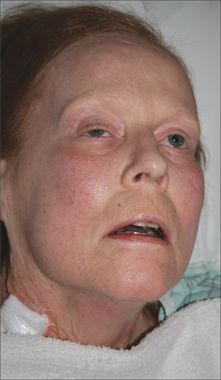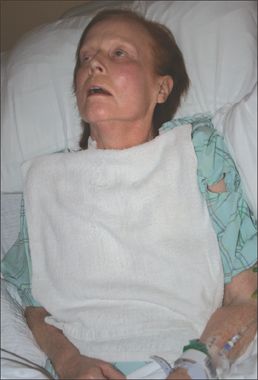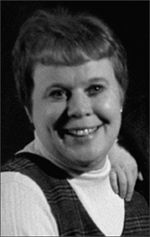- Clinical Technology
- Adult Immunization
- Hepatology
- Pediatric Immunization
- Screening
- Psychiatry
- Allergy
- Women's Health
- Cardiology
- Pediatrics
- Dermatology
- Endocrinology
- Pain Management
- Gastroenterology
- Infectious Disease
- Obesity Medicine
- Rheumatology
- Nephrology
- Neurology
- Pulmonology
Middle-aged Patient in Dire Straits
A 56-year-old woman seen during physician’s hospice visit. Stormy course from lupus nephritis, dialysisdependency, repeated episodes of dialysis-catheter–related peritonitis, each treated and followed by Clostridium difficile–associated disease.

HISTORY
A 56-year-old woman seen during physician's hospice visit. Stormy course from lupus nephritis, dialysisdependency, repeated episodes of dialysis-catheter–related peritonitis, each treated and followed by Clostridium difficile–associated disease. End-stage cardiomyopathy of mixed lupus-ischemic origin renders hemodialysis impossible. Does not wish further dialysis of any type; automatic implantable cardiac defibrillator (AICD) has been turned off. On opiates for chronic abdominal pain. Refractory but mostly morning nausea and vomiting.
PHYSICAL EXAMINATION
Intermittently lucid woman who is frequently profoundly delusional, eg, telephoning husband from hospital room to tell him she awaits him at a local department store. No abdominal tenderness or pulmonary crackles; S3 has cleared. No mottling.
"WHAT'S YOUR DIAGNOSIS?"
Answer on Next Page
ANSWER: WEARING-OUT AND THE END OF LIFE

Figure 1 – Apparent dysconjugate gaze is an artifact of position and perhaps slight lag in movement of one set of extraocular muscles. Cheeks appear a bit flushed and also somewhat telangiectatic. Mandible is more prominent than before. Chin has assumed undue bony prominence. Intravenous line in left forearm was for infusion of parenteral antiemetic and analgesic.
This image is emotionally very painful to look at, precisely because it vividly conveys loss and the imminence of death. It has this effect even upon those who had not known this woman earlier in her life, or earlier in this final illness. How does it engender our inference that she is moribund?
In part it is the gauntness, which accurately reflects loss of more than 20% of body weight over the disastrous last year, some 300 days of which were spent in countless hospital admissions typically followed by reconditioning stints at the restorative unit of our skilled nursing facility. The prominent right supraorbital ridge telegraphs loss of flesh. A receding hairline seems to underscore this. Yet a devoted certified nursing assistant had just brushed her hair with utmost gentle care, and I had noted that she appeared better kempt than on several prior visits. Loss of eyebrow hair makes the face appear more barren. The tip of the nose stands out as though flesh had receded at the inconspicuous philtrum and from the flesh of the outer rim of the bottom of the nasal septum.
Her lack of looking at the camera accurately reflects profound delirium and inability to focus on any person or thing for more than a moment, except during some of the moments with family. A second image shows similar lack of discernible awareness of the camera (Figure 1), and hints at dysconjugate gaze as well as highlighting weight loss and a flush of the cheeks.
The ptotic right eyelid is not part of her moribund state, but rather a long-term aftereffect of severe herpesvirus keratitis during one period of intense immunosuppressive therapy.
Excessive wrinkling of skin about the mouth, especially on the upper lip, augments a sense of premature aging. So does wrinkling of the neck, particularly just above a gauze that marks the site of a recent central venous catheter. These wrinkles doubtless have been amplified by weight loss.
Finally, the open mouth which might be taken as mere breathing or speech in another context, in this setting suggests inattention to self, though she is awake. The towel beneath constitutes a measure to absorb drooled saliva.
WHAT WERE WE THINKING?
We had known that uremia was in progress, yet twitching was never conspicuous and pruritus was readily managed. Multifactorial nausea and vomiting amplified longstanding peptic symptoms; these did not ease with twice-daily proton pump inhibitor dosing that had done the job when she merely had gastritis during the years on dialysis. Multiple antinausea medicines also failed to control the symptom, including mirtazapine, phenothiazines, phosphorylated fructose (Emetrol) and even ondansetron.
We watched for uremic frost1-4 but it never developed, in part because sweating was imperceptible during this admission. We thought we might see mottling of feet as intravascular volume progressively fell, and then a livedo-like pattern on shins and knees, as harbingers of death5,6; this too never happened. Our patient survived nearly 4 weeks after transfer to our facility, all of it without renal replacement therapy or any restrictions of diet or fluid intake.
Lethal ventricular arrhythmia was considered a very likely terminal event, all the more so since electrolyte disorders had caused scores of firings of her AICD in short order just before the last hospital stay. We noted with irony and sadness that these firings occurred 1 day after dialysis; the coronary care team had concluded that proven sudden-onset severe electrolyte disturbances had triggered recurrent ventricular tachycardia in the absence of new ischemia. Our patient loathed the pain and jerking of her body that each firing produced, and the events disturbed all those who observed them. Yet even when one expected the electrolytes would have the highest risk of imbalance, and when a consequent arrhythmia might have provided a gentle death with the AICD inoperative, no such event followed.
Mercifully, intractable congestive heart failure did not develop either. We had continued furosemide even with poor oral intake precisely to avoid the dreadful symptom of air hunger. After her S3 cleared, and there was no edema, we inferred hypovolemia, and then furosemide was stopped. Pump function must have been optimized by intravascular volume depletion-a physiology that when required to prevent lethal pulmonary edema, commonly precipitates cardiorenal syndrome. Any further impairment of kidney function due to further reduction in renal blood flow was of course not an issue for this patient whose baseline was end-stage renal disease.

Figure 2 – At age 40 this woman looks healthy. The tiny hand of her then-small son drapes over her shoulder. Chronic corticosteroid therapy for systemic lupus erythematosus has caused rounding of face that could be mistaken for obesity.
STARK CONTRAST,
A full sense of the visible devastation wrought by her chronic illness and its many acute complications is heightened by reviewing three photographs kindly lent to me by the patient's family and covering the years from 1996 (Figure 2) through 1999 (Figure 3) to approximately 2005 (Figure 4). I only took care of her during several stays at our facility in the last 5 years of life, yet even to me the external changes proved stunningly upsetting. Of course they corresponded to the depth and complexity of internal derangements, and of course one understands this intellectually, but the profound external change that renders a patient almost unrecognizable will distress any clinician, perhaps all the more so when illness and death cut a life short.
WHAT ARE WE TO DO WITH OUR INFERENCES?
Is there a point to recognizing imminent death on physical examination? Or is this exercise merely a species of hollow virtuosity or worse yet a kind of medical voyeurism? Of course I would not have taken these photographs, with the blessing of family and patient, had I not intended them to do good. First, we must be infinitely humble about predicting time of death: truly, and for the fourth day in a row, I had felt that based on appearance, my patient would die that very day. She lived almost another 3 days. I had actually thought she would perish on the day of admission 4 weeks earlier, but after some sleep, some quiet, optimal analgesia, and the control that she was given back, she had rallied next morning, and then all my protests to the family, that I cannot really prognosticate closely, nor can any clinician, made better sense. Yet as they bore witness on a loving vigil over the days that followed they kept asking how long I thought she could last, and I kept trying, in stumbling fashion and with infinite reservations, to answer.

Figure 3 – Eleven years before death, she is vibrant and joyous in a family portrait. Ptosis of right eyelid has not yet begun. Her face is not so wide as in the prior photograph.
Second, the face of death, like that of every malady, is less frightening once we have viewed it on many persons and in many contexts. We have to remind ourselves and accept that death is the fate of every living thing. Our work is to prevent avoidable and premature death, and to alleviate suffering, and to optimize function and thereby quality of life. But if we indulge in the "warrior against death" mentality, we have to acknowledge that we will lose every such battle over time.
And that model is wrong: There comes a time when suffering is all that remains, and where life has devolved into an unending series of calamities and miseries. When this is the reality for our patient, we need to be clear-eyed, to help explicate that this is the state, to draw on our objectivity, our experience of prior parallel cases, and our technical knowledge7 to help patient and family make realistic choices. We need, at that moment if not long before, to recognize that our still-vital role becomes one of support, symptom control, and humaneness. Support is a proud part of medicine.8 Our presence, our words, and our avoidance of futile frenzy are great blessings for patient and family. We need to remind ourselves regularly that death does not equal physician failure or clinician failure, and that this is true not only if we have consulted hospice, but in many other settings as well. The death rate now as in antiquity remains one per life, and none of our armamentarium-not nth-generation cephalosporins, not minimally invasive surgery, not the newest MRI-changes that.

Figure 4 – Even a year or so before starting dialysis, she looks more youthful than her chronological age. Appearance gives sound impression of strength both physical and in spirit. Right eyelid shows early stage of its drooping. Eyebrows appear normal.
LETTER, WAKE, FUNERAL
A coda: I sent a heartfelt note to the family after the patient died even though I had just seen them face to face. I am convinced this action is of value not only to a family, but to the psyche of the clinician9 and also to the status and honor of our profession.
Although one cannot always do so, whether for practical reasons or because one will become too depleted and must guard against over-involvement that can impair professional judgment or can render one emotionally exhausted, I chose to attend the wake, and found great comfort in doing so.
For the first time in my life, I saw that the face of the person in the coffin had actually been prepared so well by funeral staff that she looked more like herself, less like when she was moribund.
Soon afterward I received truly beautiful letters from both the husband and the adolescent son of this patient. Sharing the story is another part of my healing in the wake of my loss as a physician of a patient I had become very fond of, and a family whose perspective and steadfastness had earned my respect and affection far earlier on the long tough road that they walked with this lady.
Schneiderman H. Wearing-out, the end of life, and what our work entails then. CONSULTANT. 2010;50:210-216.
References:
REFERENCES:
1.
Schneiderman H. Uremic frost.
Consultant
. 1990;30(6):37-38.
2.
Pol-Rodriguez MM, Wanner M, Bhat P, Grossman ME. Uremic frost in a critically ill patient.
Kidney Int
. 2008;73:790.
3.
Walsh SR, Parada NA. Images in clinical medicine. Uremic frost.
N Engl J Med
. 2005;352:e13.
4.
Bhattarai N, Panda M. Uremic frost.
Mayo Clin Proc
. 2008;83:1309.
5.
Brandt J. Intermittent skin mottling in elderly patients.
J Am Geriatr Soc
. 1987;35:478.
6.
Schneiderman H. New mottling especially at the knees and physical examination at the end of life.
Consultant
. 2001;41:89-93.
7.
Schneiderman H. 100 Precepts for my house staff.
Consultant
. 2009;49:270-276, 361-365.
8.
Aoun H. From the eye of the storm, with the eyes of a physician.
Ann Intern Med
. 1992;116:335-338.
9.
Bedell SE, Cadenhead K, Graboys TB. The doctor's letter of condolence.
N Engl J Med
. 2001;344:1162-1164.
FDA Approves First Oral GLP-1 Receptor Agonist for Chronic Weight Management
December 23rd 2025The FDA approved once-daily oral semaglutide 25 mg for chronic weight management and long-term weight maintenance in adults with obesity or overweight, based on data from the OASIS clinical trial program.
Phase 3 Data Support Oral Orforglipron for Weight Maintenance After GLP-1–Based Weight Loss
December 19th 2025Topline Phase 3 ATTAIN-MAINTAIN data show oral orforglipron met primary and key secondary endpoints for weight maintenance after prior GLP-1–based injectable therapy in adults with obesity.
